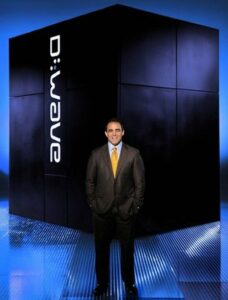This May, tech-super-giant Google has combined their efforts with NASA and the Universities Space Research Association (USRA, a long-standing coalition of universities founded in 1969) to utilize new, promising technology. The group has purchased a brand new computer for $15 million that can run at speeds up to 3,600 times faster than a normal computer, and is slated to be installed at a NASA facility where the organizations can share it. But this computer may be unlike any computer you’ve ever heard about.
It’s called the “D-Wave-Two”, and it is the front-runner in a burgeoning field of development called Quantum Computing. Quantum Computers – a subject that has largely been theoretical until very recently – utilize the odd and esoteric rules of Quantum Mechanics to solve problems and run algorithms faster than a traditional computer can, sometimes thousands of times faster. Multiple companies and research groups have sprouted up in the last decade to chase the potential that these theoretical computers hold, including D-Wave, the company that created the machine in question.

Quantum What-now?
What makes these quantum computers so special? To understand a quantum computer, you need to first understand two things: classical computers and quantum mechanics. Quantum computers rely mainly upon the related concepts of superposition and entanglement. Without getting bogged down in the math and science involved, you have to imagine an atom. The atom might be moving, or standing still; it might have a lot of energy or it might have very little. Superposition simply means that unlike a normal-sized object (like a baseball), the atom – until examined – is in all states at once. Essentially, if an atom falls in the forest, and no one is around to see it, then it has fallen and also hasn’t fallen!
This strange phenomenon has been well-documented for decades now, and much of our current technology has begun to rely on it, but none rely on it as much as the a quantum computer does. In a classical computer, data is stored in “bits:” 1’s and 0’s. A bit can only be one thing or the other, like a switch that is either “on” or “off.” But a quantum computer doesn’t use bits, it uses “qubits” (that’s right, it’s shortened from “quantum bits“). A qubit, like the atom in the paragraph above, can be in multiple states at once, which means it is both on and off at the same time.
Quantum Computers are made up of hundreds or more of these qubits, and they use them much like a typical computer uses its bits, to input problems and output solutions. But because a qubit can be in multiple states at once, it is vastly more efficient than a regular bit. A 500-qubit quantum computer is much more powerful than a classical computer with billions of traditional bits.

Yes, but why do I care again?
Quantum Computing stands to turn the field of computer science on its head in multiple ways. One is cryptography, where unsolvable problems are commonly used to protect information, like bitcoin trails, classified government information, and even your bank account. But these unsolvable problems are easily solved by quantum methods. Fully functioning Quantum Computers would crack open all of those vaults, forcing the tech-world to adapt to new strategies and ideas.
Quantum Computers have other potential uses than just undermining your bank security, though. The Google/NASA/USRA super-team are planning to use their machine to study how quantum computers could revolutionize the pursuit of artificial intelligence; that’s why they’re calling this new lab the Quantum Artificial Intelligence Lab. The D-Wave-Two could be the next major step toward a learning, functioning, intelligent computer.
But don’t worry about super-hackers or Skynet anytime soon. Quantum Computing still has a long way to go before it will be market-viable. D-Wave has faced a great deal of criticism on their methods: some say that the way they manipulate their qubits will never lead to a realistic large-scale machine, and others question whether they’ve even utilized actual quantum principles in their designs. Google and NASA say they’ve tested the technology and found it successful, but there are still doubters. D-Wave isn’t the only company out there working on quantum computers, though. Just a few days ago, an Australian Team announced a phosphorous-based quantum chip that they believe could be scalable into fully-functioning, marketable computers. And even the formidable IBM has entered the fray.
Google says this research will help it improve its Web Searching and Speech Recognition technologies, but that may not be the end. What was once the purview of science-fiction may be closer than we thought to becoming a reality, even for the average consumer. Imagine a learning, creative AI integrated into your computer, or even your phone! In a decade or two, smart phones may truly become smart phones, and Quantum Computers like the D-Wave-Two will be how.

